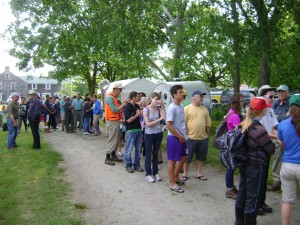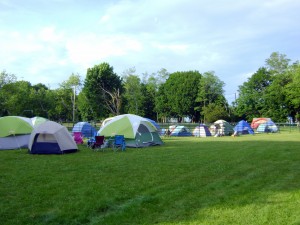Flashback: BioBlitz 2012
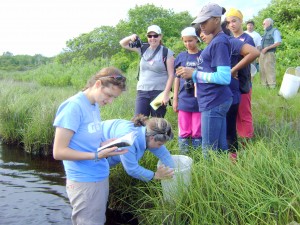 Note: This June 7 & 8, Rhode Island Natural History Survey (RINHS.org) will host the 14th annual BioBlitz. In anticipation of that amazing adventure, here’s a look at last year’s festivities.
Note: This June 7 & 8, Rhode Island Natural History Survey (RINHS.org) will host the 14th annual BioBlitz. In anticipation of that amazing adventure, here’s a look at last year’s festivities.
“Check this out!” A noisy gathering of teenagers jog up to David Gregg, Executive Director of the Rhode Island Natural History Survey (RINHS). One teen holds a plastic container with a snake inside. “We found a dead brown snake!” he exclaims. “Cool!” Gregg says. “And it had a carrion beetle on it!” “Wow!” Welcome to BioBlitz 2012, where finding a dead snake is cool, but finding one being eaten by a carrion beetle is, well, awesome.
Now in its thirteenth year, BioBlitz is where hundreds of scientists descend on a select area, determined to record every living creature they find in a 24-hour period. The event, organized by RINHS, is part scientific assessment, part class reunion. It is designed both to gain perspective on the biological health of a given area and to bring together a wide range of scientists, naturalists, and conservationists, all of whom belong to the clearing house of knowledge that is RINHS.
Strolling along the path leading to the shore reveals observers scattered everywhere. Participants are divided into teams, and at the moment some tout nets for bees and wasps, others bend gathering plants, while still others are scan the skies with binoculars in search of every species of bird in the area. The 600-acre Jamestown parcel that comprises the site of BioBlitz represents a wealth of habitats: woods, open fields, plowed farmland, fresh and salt water.
At the shore, Central Falls Science teacher Stephanie Racine leads a group of middle school students, all of whom sport the navy blue t-shirt designed for this year’s BioBlitz. This is the third year Racine has volunteered to bring students along with her, some of whom have only been in the U.S. for a matter of months. They are part of a science English as a Second Language (ESL) class, and are learning as much about the language as about science. At least one of the students is seeing the salt water for the first time. All of them live in an area where wide open spaces simply do not exist. 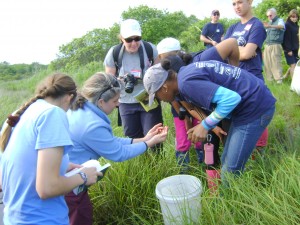
Laughing and chattering, they challenge one another to hold the samples brought up in a seine net by a pair of marine biologists. “Mercedes, wanna hold it?” asks one girl holding a green crab, which is expressing its displeasure at being interrupted by frantically trying to pinch its way out of a jam. Mercedes declines, while others take the dare. Racine asks the students questions about their observations, and some of them eagerly put samples of the creatures in buckets to bring back for further examination. They fill in a checklist with the name of the creature they have found. “We had one girl who had said she wanted to be a doctor before today,” Racine said with a smile. “By this afternoon she said, ‘Miss, I changed my mind. I want to be a scientist and be outside instead.’”
At six, with the sun still shining in a blue sky, it’s time for supper. Though there is a long line of diners awaiting a meal, no one seems to mind.
There is much chatter and numerous hugs for participants who may not have seen each other since last year’s event. All of them update their progress, and offer excited congratulations on the catches thus far. BioBlitz will continue through the night for some, and there are sweet treats and coffee at the ready. As night begins to descend, there are other creatures who will emerge and need to be counted.
Among the nocturnals are, of course, moths. Several light traps need to be set up in order to enable a count. The trap consists of a small light perched atop a five gallon bucket. Moths drawn to the light will likely bump into one of the four Plexiglas panels that protrudes from the center. They will then drop into the bucket, where a chemical will quickly dispatch them for a count the next morning. It is perhaps the only time critters will be killed in the event, a necessity in order to count the creatures of darkness.
With light traps in place, there is time to visit other teams. The anchor to the entire event is Science Central. It is aptly named, the hub of considerable activity. Inside the canopied area, a mass of electrical cords power myriad microscopes and magnifying lights. The tables are spread with laptops, field guides, sample trays, mosses, insects, ferns, mollusks, and endless other samples brought for identification. 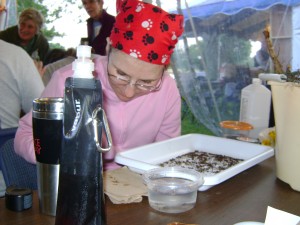
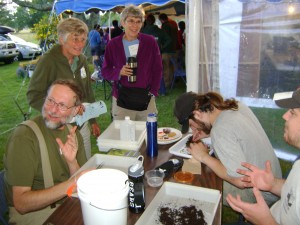
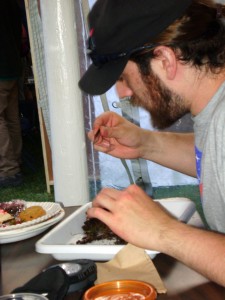
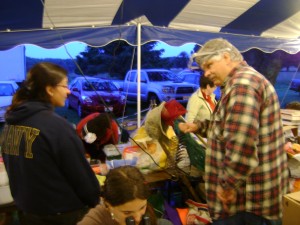
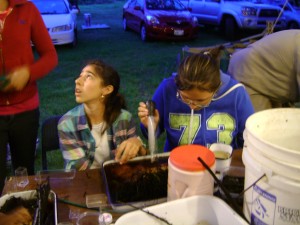
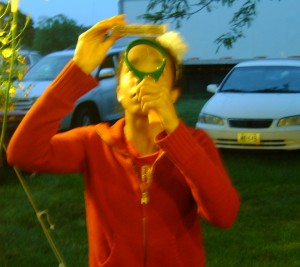
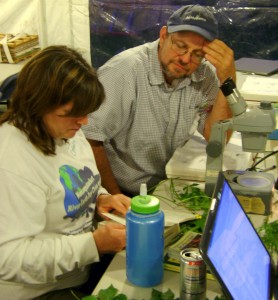
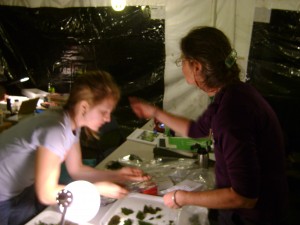 Teams are bent over trays containing leaf litter. One astronomer, accustomed to searching the deepest regions of space, is poring over a tray of dirt, looking for tiny signs of life. This crossover of specialties is not uncommon, as scientists sometimes take a break from their usual work to pursue other areas of curiosity. The samples are sorted first with the naked eye, then a magnifier, and finally with a microscope. A handsome young man sporting nappy dreadlocks and piercings is in charge of the microscope for this crew tonight. He points out a seed-shaped creature he has found with his scope, much too small be seen easily, but a fine addition to the count nevertheless.
Teams are bent over trays containing leaf litter. One astronomer, accustomed to searching the deepest regions of space, is poring over a tray of dirt, looking for tiny signs of life. This crossover of specialties is not uncommon, as scientists sometimes take a break from their usual work to pursue other areas of curiosity. The samples are sorted first with the naked eye, then a magnifier, and finally with a microscope. A handsome young man sporting nappy dreadlocks and piercings is in charge of the microscope for this crew tonight. He points out a seed-shaped creature he has found with his scope, much too small be seen easily, but a fine addition to the count nevertheless.
Unlike other years, the weather has been spectacular so far, with cool breezes and clear skies. As evening rolls on, though, rumbles of thunder turn apprehensive eyes toward the skies. So far, the only lightning comes from the magical sparkles of lightning bugs, twinkling their availability to potential mates. A walk down a dirt road reveals other signs of life: participants wearing headlamps in search of night insects, and a man leaning against a pickup truck. The man is DEM biologist Charles Brown, out tonight to set up nets in the hopes of capturing bats. Rhode Island is home to several species of bats, most commonly the Little Brown Bat. There are no captures yet, but the mood remains hopeful.
There are a few campfires burning in “the village”, as the tent area is called, and teens from various organizations engage in noisy conversations. At Science Central, many will work through the night, and still others will be out in the fields searching for still more species. Finally, it’s time to turn in for the night.
A rooster’s crowing signals the morning. Somehow the impression was that it would be full daylight before the bird began reveille, but that was a sad mistake. It’s 4:45 a.m., and the rooster shows no sign of ceasing his call. After a half hour of vain attempts to doze off, it’s time to face reality and crawl out of the tent.
The people stand around the registration tent, where thankfully there is hot coffee. Everyone looks a bit beat up, since even those who did not intentionally spend a sleepless night identifying creatures caught precious little sleep. No one complains, though, for there is hot coffee and good company in plentiful supply. Yesterday’s counting process continues in earnest. In a short while, several people stroll by carrying not buckets and nets, but charcoal pencils and paper.
These are members of the art team, a recent addition to Bioblitz. This is a group of people who have chosen to use the hundreds of natural samples and bucolic surrounding as inspiration for creating art. They are sculptors, painters, sketch artists, photographers and others, and a group of them head out to the fields to scatter and sketch what they see. Eventually, the team will pool its creations for a show at the Warwick Museum of Art.
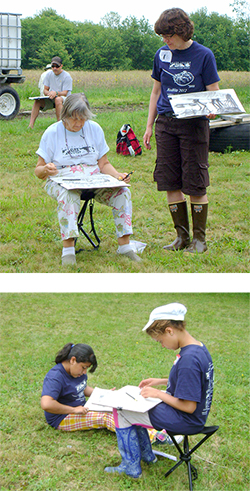 By the time the horn blows 24 hours after it all began, the hundreds of participants will have tallied over 1200 species of life. The information will be put into a database as a reference for scientists interested in a supplement to determining the overall health of the local environment. Yet at the same time, there is an equal feeling that this has been just phenomenal fun, and more than a few folks are discussing plans for next year.
By the time the horn blows 24 hours after it all began, the hundreds of participants will have tallied over 1200 species of life. The information will be put into a database as a reference for scientists interested in a supplement to determining the overall health of the local environment. Yet at the same time, there is an equal feeling that this has been just phenomenal fun, and more than a few folks are discussing plans for next year.
Back at the tent for one last cup of coffee, someone goes to cap a container of half and half. “Better to keep the bugs out,” he says. Without hesitation, the man behind him deadpans, “With this crowd, you can bet there’d be someone happy to identify it for you if it did get in!”

